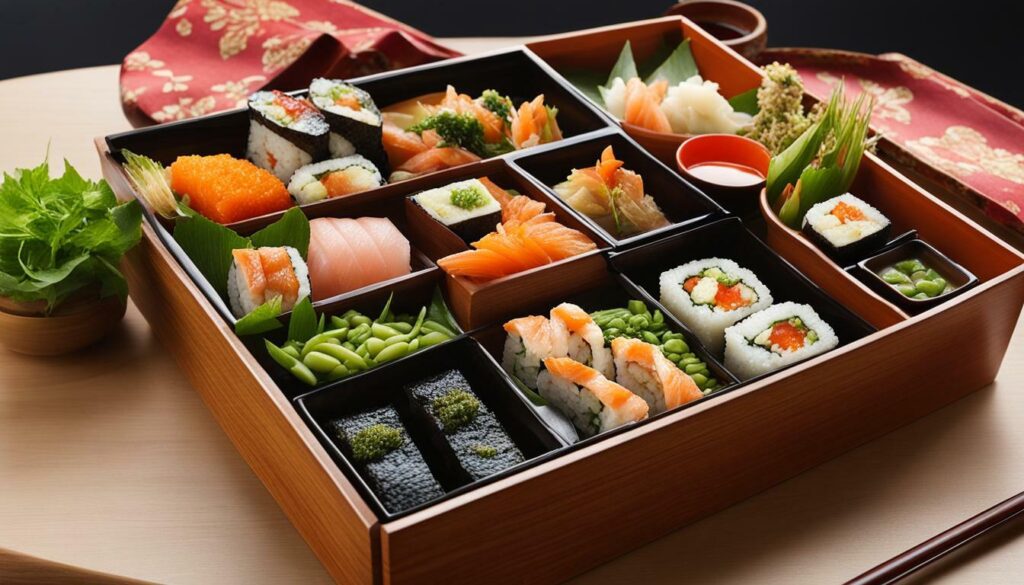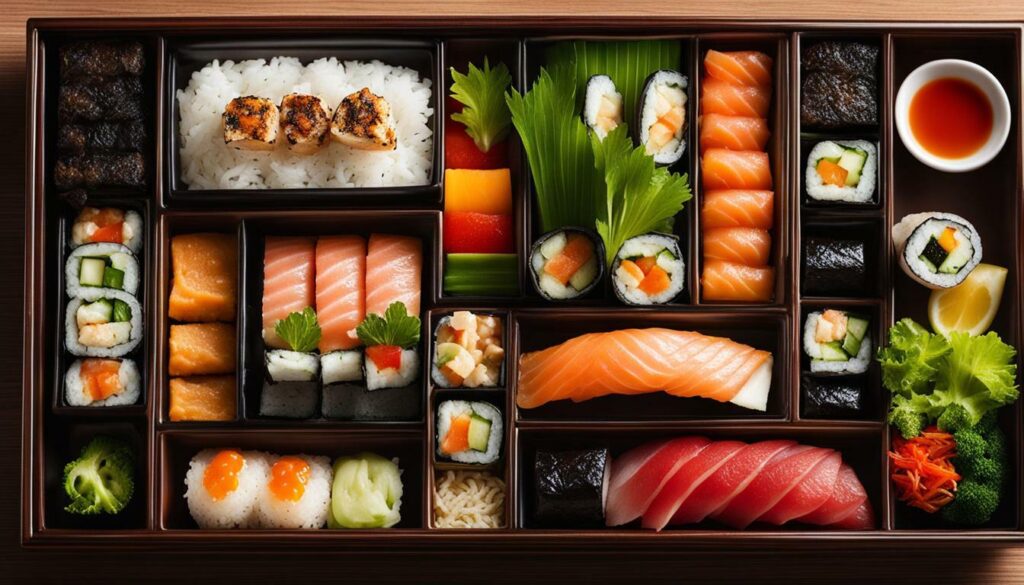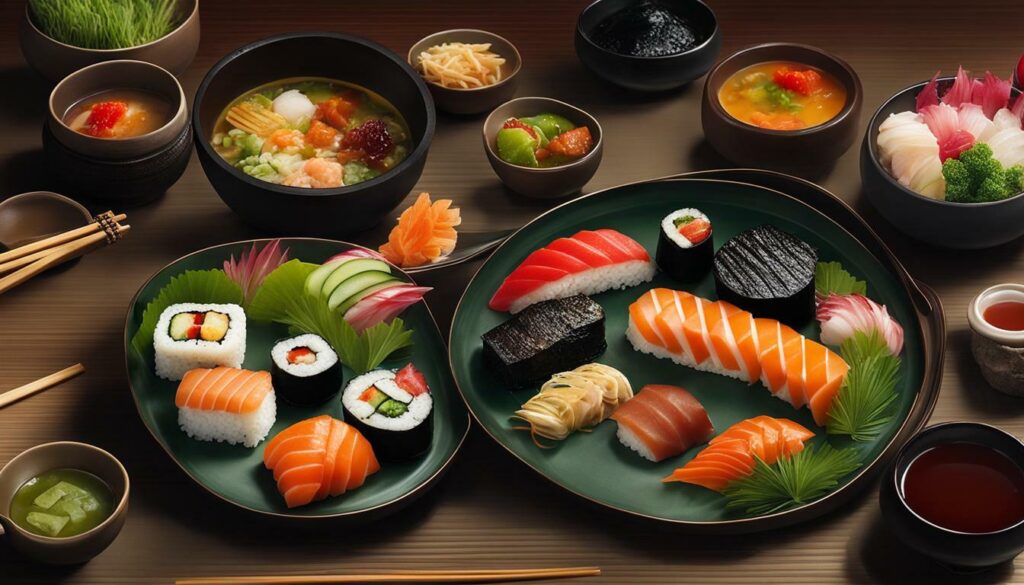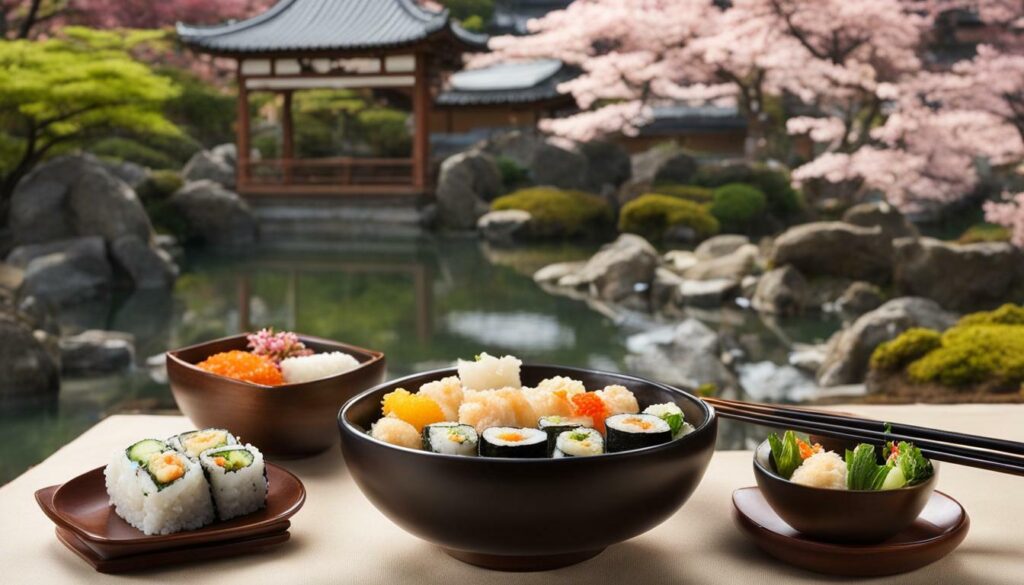The past and present diets of Japan offer a fascinating glimpse into the evolution of Japanese cuisine and the traditional foods that have shaped the nation’s culinary landscape.
In the past, the traditional Japanese diet was primarily vegetarian, with a strong focus on rice, vegetables, and fish. This diet was not only nutrient-rich but also aligned with principles of simplicity, freshness, and seasonality. Over time, Japanese cuisine has evolved, incorporating new ingredients and flavors, while still preserving the essence of traditional dishes.
The traditional Japanese diet is known for its potential health benefits. Studies have shown that following this diet can improve digestion, aid in weight loss, promote longevity, and protect against chronic diseases. The emphasis on natural flavours and visual appeal, along with the consumption of a variety of nutrients from different food groups, contributes to the overall well-being of those who adhere to this dietary pattern.
Key Takeaways:
- The traditional Japanese diet focuses on rice, vegetables, and fish.
- It is rich in nutrients and promotes overall well-being.
- The diet emphasizes simplicity, freshness, and seasonality.
- Traditional Japanese meals consist of staple foods, soups, main dishes, and various side dishes.
- Studies have linked the traditional Japanese diet to improved brain health and cognitive well-being.
The Traditional Japanese Diet
The traditional Japanese diet, rooted in rice, vegetables, and fish, forms the foundation of Japan’s culinary heritage and is renowned for its nutritional benefits. This diet, which dates back centuries, exemplifies the simplicity, freshness, and seasonality of Japanese cuisine. It consists of small dishes that are visually appealing and emphasize natural flavours. The traditional Japanese diet has been studied for its potential health benefits, including improved digestion, weight loss, longevity, and protection against chronic diseases.
At the heart of the traditional Japanese diet are staple foods such as rice or noodles, which provide energy and satisfy hunger. These are accompanied by a variety of side dishes, including soups, main dishes of seafood or tofu, and an array of vegetables and seaweed. The use of fresh, local, and seasonal ingredients ensures that meals are not only nutritious but also full of flavour.
One of the distinctive features of the traditional Japanese diet is its low consumption of added sugars, fats, and animal protein. Instead, it focuses on nutrient-dense foods such as vegetables, fish, and soy-based products. This balanced approach to eating not only provides essential vitamins and minerals but also contributes to maintaining a healthy weight and overall well-being.

“The traditional Japanese diet is not only a way of eating but also a cultural practice that promotes good health and longevity.”
Components of the Traditional Japanese Diet
The traditional Japanese diet consists of a harmonious combination of staple foods, soups, main dishes, and side dishes, each carefully prepared using fresh and seasonal ingredients. It is a diet that focuses on simplicity, balance, and natural flavours, resulting in a culinary experience that is both visually appealing and nutritious.
At the centre of a traditional Japanese meal is a staple food, usually rice or noodles. These carbohydrates provide energy and serve as a foundation for the meal. Soups, such as miso soup or clear broth, accompany the staple food and provide hydration and additional nutrients.
Main dishes in the traditional Japanese diet typically include seafood or tofu. Seafood, particularly fish, is a prominent feature due to Japan’s abundant coastal resources. The inclusion of seafood ensures a good source of omega-3 fatty acids, which are beneficial for heart health. Tofu, made from soybeans, is a versatile and protein-rich alternative for those who follow a vegetarian or vegan diet.
Complementing the main dishes are a variety of side dishes, which often consist of vegetables and seaweed. These side dishes add colour, texture, and a range of vitamins and minerals to the meal. Vegetables are typically cooked lightly to retain their natural flavours and nutritional value, while seaweed provides additional minerals and umami, a savoury taste.

| Staple Foods | Soups | Main Dishes | Side Dishes |
|---|---|---|---|
| Rice | Miso Soup | Fish | Vegetables |
| Noodles | Clear Broth | Tofu | Seaweed |
In summary, the traditional Japanese diet is a testament to the country’s rich culinary heritage. It is a diet that values simplicity, balance, and freshness, offering a wide range of flavours and textures. The combination of staple foods, soups, main dishes, and side dishes ensures a well-rounded and nutritious meal. Whether it’s the nutrient-rich seafood, the umami-packed seaweed, or the vibrant array of seasonal vegetables, the traditional Japanese diet exemplifies the beauty of Japanese cuisine.
Health Benefits of the Traditional Japanese Diet
Following the traditional Japanese diet can have a profound impact on one’s health, with numerous benefits including improved digestion, weight management, and enhanced longevity. The diet, which is primarily vegetarian and focuses on rice, vegetables, and fish, is rich in nutrients and low in added sugars, fats, and animal protein.
The traditional Japanese diet consists of small, visually appealing dishes with an emphasis on simplicity, freshness, and seasonality. By incorporating staple foods like rice or noodles, a soup, a main dish of seafood or tofu, and various side dishes of vegetables and seaweed, the diet provides a balanced and nutrient-dense meal.
This nutrient-rich nature of the traditional Japanese diet has been linked to improved brain health and cognitive well-being. The abundance of vitamins, minerals, antioxidants, and omega-3 fatty acids found in the diet may help preserve psychological and cognitive health, reducing the risk of cognitive decline and age-related diseases.
The Impact of Japanese Diet on Brain Health
Studies have shown that following the traditional Japanese diet is associated with a lower risk of developing Alzheimer’s disease and other forms of dementia. The consumption of fish, which is rich in omega-3 fatty acids, has been particularly linked to cognitive benefits, including improved memory and concentration.
| Health Benefits | Summary |
|---|---|
| Improved Digestion | The high fibre content of the traditional Japanese diet promotes healthy digestion and prevents constipation. |
| Weight Management | The nutrient-dense, low-calorie nature of the diet, combined with portion control, can contribute to maintaining a healthy weight. |
| Enhanced Longevity | The longevity of the Japanese population has been attributed, in part, to their traditional diet and healthy lifestyle habits. |
The traditional Japanese diet, with its focus on natural flavours, fresh ingredients, and balanced nutrition, offers a holistic approach to overall well-being. It not only nourishes the body but also celebrates the cultural heritage and culinary traditions of Japan.

Evolving Japanese Cuisine
Japan’s cuisine has undergone significant evolution, embracing new ingredients, flavours, and international influences while staying true to traditional Japanese culinary principles. After World War II, Japan experienced a shift from privation to plenty, which brought about changes in the country’s food habits. As affluence grew, so did the availability of ingredients from around the world, leading to the incorporation of new flavours and the adaptation of foreign recipes to fit traditional Japanese ideas about portion size and meal structure.
The evolution of Japanese cuisine has resulted in a diverse culinary landscape, where traditional dishes coexist with modern creations. Festive foods in Japan now include a wide range of dishes, such as sushi, tempura, and yakitori, which have gained popularity both in Japan and internationally. These dishes showcase the creativity and adaptability of Japanese chefs, who have mastered the art of combining new ingredients with traditional cooking techniques.
Popular foods in Japan reflect the changing tastes and preferences of the population. Western-inspired dishes like curry rice and ramen have become staples in Japanese households, blending seamlessly with traditional dishes like miso soup and grilled fish. The Japanese now eat choosily, pleasurably, and healthily, demonstrating that food habits can evolve while still maintaining a strong connection to cultural roots.

“Japanese cuisine is a beautiful blend of tradition and innovation, with an emphasis on fresh, seasonal ingredients and exquisite presentation. It is a true reflection of Japan’s cultural heritage and its ability to embrace change while preserving its culinary identity.”
The Influence of International Flavors
International flavours have played a significant role in shaping Japanese cuisine over the years. The introduction of ingredients like potatoes, tomatoes, and chilli peppers has spurred the creation of new dishes that seamlessly combine Japanese and foreign flavours. Examples include Japanese-style curry, which features a unique blend of aromatic spices, and Japanese-style pasta, which incorporates local ingredients like seaweed and soy sauce.
The ongoing evolution of Japanese cuisine highlights the dynamic nature of culinary traditions. Japan’s chefs continue to explore new flavors, techniques, and ingredients, while still honoring the foundations of traditional Japanese cooking. This balance between tradition and innovation is what makes Japanese cuisine so unique and captivating, attracting food enthusiasts from around the world who are eager to experience the harmonious blend of flavours and the exquisite artistry that Japanese chefs bring to each dish.
Summary
- Japanese cuisine has evolved, embracing new ingredients, flavours, and international influences while staying true to traditional culinary principles.
- After World War II, Japan experienced a shift from privation to plenty, leading to the incorporation of new flavours and the adaptation of foreign recipes.
- Festive foods in Japan now include a wide range of dishes that showcase the creativity and adaptability of Japanese chefs.
- The Japanese now eat choosily, pleasurably, and healthily, demonstrating that food habits can evolve while maintaining cultural roots.
Modern Japanese Food Habits
Today, the Japanese are known for their discerning and health-conscious approach to food, indulging in a variety of flavorful and nutritious meals that celebrate the country’s culinary heritage. Japanese meals are not only a source of sustenance but also a form of artistic expression, with each dish carefully prepared and presented to entice both the palate and the eyes.
The modern Japanese diet reflects a balance between traditional and contemporary influences, combining the principles of the traditional Japanese diet with the convenience and global flavours of modern cuisine. While still rooted in the principles of simplicity, freshness, and seasonality, Japanese recipes have evolved to incorporate new ingredients, cooking techniques, and flavours from around the world.
A typical Japanese meal consists of a variety of small dishes, each highlighting a different ingredient and flavour profile. This allows for a diverse range of textures and tastes, ensuring a satisfying and well-rounded dining experience. The emphasis on portion control and mindful eating also plays a significant role in Japanese food habits, with meals often featuring a wide variety of vegetables, lean proteins, and whole grains.
Sample Japanese Meal:
| Dish | Description |
|---|---|
| Sushi | A traditional Japanese dish of vinegar-seasoned rice topped with raw or cooked fish, seafood, or vegetables. |
| Miso Soup | A savoury soup made from fermented soybean paste (miso) and often flavoured with tofu, seaweed, and green onions. |
| Tempura | Lightly battered and deep-fried seafood or vegetables. |
| Grilled Fish | A fillet of fish seasoned and grilled to perfection often served with a side of steamed rice. |
| Seaweed Salad | A refreshing salad made from various types of seaweed, dressed with a tangy vinaigrette. |
| Tofu with Vegetables | Soft and silky tofu accompanied by a medley of sautéed or steamed vegetables. |

The Japanese approach to mealtime extends beyond the food itself. It encompasses the ambience, the company, and the mindfulness with which each bite is savoured. The ritual of a Japanese meal encourages a slower pace, allowing for a deeper connection with the food and an appreciation of its flavours and textures.
In conclusion, modern Japanese food habits combine the best of tradition and innovation. By embracing change and incorporating diverse ingredients and flavours, the Japanese continue to enjoy meals that are both nourishing and pleasurable, reflecting their deep appreciation for food as an integral part of their culture and identity.
The Role of Food in Japanese Culture
Food holds a special place in Japanese culture, with iconic dishes representing the nation and traditional meals playing a central role in festive occasions and daily life. From delicate sushi to savoury ramen, Japanese cuisine is renowned worldwide for its unique flavours and meticulous preparation. The appreciation for food goes beyond mere sustenance; it is an art form that reflects the country’s rich history, natural resources, and deep-rooted traditions.
In Japan, meals are not just about nourishment; they are a way of connecting with others and expressing gratitude. The act of sharing a meal is considered a social bond, strengthening relationships and fostering a sense of community. Japanese etiquette emphasizes mindfulness and respect for food, with practices such as saying “itadakimasu” before a meal to express gratitude and recognise the efforts of the farmers, fishermen, and chefs who contributed to the meal.
The cultural significance of food is evident in festive celebrations throughout Japan. From the elaborate dishes served during New Year’s celebrations to the delicate sweets enjoyed during tea ceremonies, each occasion is marked by unique culinary traditions. Traditional ingredients, such as seaweed, soba noodles, and matcha green tea, are thoughtfully incorporated into these dishes, representing the harmony between nature and human creativity.
Japanese cuisine has gained international recognition for its diverse range of dishes. From the comforting warmth of miso soup to the intricate presentation of sushi, each bite tells a story, encapsulating the essence of Japanese culture. The meticulous attention to detail, use of fresh and seasonal ingredients, and focus on simplicity and balance are all hallmarks of Japanese cuisine that contribute to its status as a world-renowned culinary tradition.

The Impact of Japanese Diet on Brain Health
The traditional Japanese diet’s emphasis on nutrient-rich ingredients has been associated with improved brain health and cognitive well-being. The Japanese have long recognized the importance of food in promoting overall well-being, and their cuisine reflects this belief. The traditional diet, which is centred around rice, vegetables, and fish, provides essential nutrients that support brain function and mental clarity.
A key characteristic of the traditional Japanese diet is its focus on fresh and seasonal ingredients. The Japanese value the quality and natural flavours of their food, and this emphasis on freshness extends to their consumption of seafood, which is rich in omega-3 fatty acids. These healthy fats have been linked to improved cognitive function and a reduced risk of cognitive decline.
Another notable aspect of the traditional Japanese diet is its low intake of added sugars, fats, and animal protein. Instead, the emphasis is on smaller portions and a diverse range of vegetables. The inclusion of fermented foods, such as miso and pickled vegetables, further enhances the diet’s nutritional profile by promoting a healthy gut microbiome. Emerging research suggests that a healthy gut microbiome is closely linked to brain health and may play a role in reducing the risk of neurodegenerative diseases.
Adopting a traditional Japanese diet can be beneficial for individuals looking to support their brain health. By focusing on nutrient-dense foods and mindful eating habits, one can enjoy the numerous health benefits associated with this culinary tradition. It’s worth noting that the traditional Japanese diet is not just about the food itself but also about the overall approach to eating, which emphasizes moderation, balance, and appreciation for the natural flavours and visual appeal of each dish.

| Nutrient | Food Sources |
|---|---|
| Omega-3 fatty acids | Fatty fish (salmon, mackerel, sardines) |
| Antioxidants | Green tea, berries, soybeans |
| Fibre | Vegetables, whole grains, legumes |
| Probiotics | Fermented foods (miso, sauerkraut, kimchi) |
| Vitamins and minerals | Fruits, vegetables, seafood |
Embracing Change: The Evolution of Food Habits
The evolving food habits in Japan showcase a harmonious blend of traditional culinary practices and the embrace of new flavours and ingredients. Japan’s cuisine has undergone significant transformation over time, reflecting the country’s historical shifts and cultural influences. After World War II, Japan experienced a period of rapid modernization and economic growth, which brought about changes in food availability and consumption patterns.
With newfound affluence, the Japanese began incorporating new ingredients and flavours into their traditional dishes. They embraced foreign recipes, adapting them to fit traditional Japanese ideas about portion size and meal structure. This fusion of traditional and modern elements resulted in a diverse and innovative culinary landscape.
The Japanese now approach food with a discerning palate, valuing not only taste but also visual appeal and nutritional value. They appreciate the importance of fresh and seasonal ingredients, carefully selecting and preparing their meals to ensure both pleasure and health. Traditional dishes such as sushi, tempura, and ramen continue to be popular, but there is also a growing interest in international cuisines and innovative cooking techniques.

The evolving food habits in Japan reflect a cultural appreciation for the past while embracing the present. It is a testament to the adaptability and creativity of the Japanese people, who have managed to preserve their culinary traditions while embracing the influences of globalization.
| Traditional Japanese Foods | Modern Influences |
|---|---|
| Sushi | Fusion Sushi |
| Miso Soup | Miso Ramen |
| Tempura | Tempura Ice Cream |
As seen in the table above, traditional Japanese foods have been adapted and given a modern twist. The incorporation of foreign flavours and ingredients has enhanced the culinary landscape, offering a wide variety of choices for both locals and visitors. The rich history and evolution of Japan’s food habits are a source of pride and fascination, showcasing the country’s unique blend of tradition and innovation.
Japans Street Food
Conclusion
The past and present diets of Japan have shaped a rich culinary heritage, with traditional foods and modern adaptations reflecting the nation’s cultural diversity and gastronomic excellence. The traditional Japanese diet, once primarily vegetarian and centred around rice, vegetables, and fish, is renowned for its nutrient-rich nature and potential health benefits. By emphasizing simplicity, freshness, and seasonality, the diet consists of staple foods like rice or noodles, soups, main dishes of seafood or tofu, and various side dishes of vegetables and seaweed.
Over time, Japan’s cuisine has evolved, incorporating new ingredients and flavours. After World War II, the shift from privation to plenty brought affluence and the introduction of foreign recipes, which were adapted to fit traditional Japanese ideas about portion size and meal structure. Despite these changes, the Japanese continue to prioritize mindful eating and the use of fresh and seasonal ingredients.
The traditional Japanese diet has been linked to improved brain health and cognitive well-being. Its nutrient-rich nature may help preserve psychological and cognitive health, contributing to the longevity and well-being of the Japanese population. The balance between traditional and modern influences in Japanese cuisine demonstrates that culinary traditions can adapt and evolve without compromising their cultural significance.
Overall, the past and present diets of Japan have shaped a culinary legacy that celebrates the beauty of simplicity, the importance of fresh ingredients, and the harmony between flavour and visual appeal. From traditional dishes to modern adaptations, Japanese cuisine continues to captivate the world with its rich flavours, cultural significance, and commitment to health and well-being.
FAQ
What is the traditional Japanese diet?
The traditional Japanese diet was once vegetarian, consisting of rice, vegetables, and fish.
What are the health benefits of the traditional Japanese diet?
The traditional Japanese diet may improve digestion, aid in weight loss, promote longevity and protect against chronic diseases.
What are the components of the traditional Japanese diet?
The traditional Japanese diet includes staple foods like rice or noodles, soups, main dishes of seafood or tofu, and various side dishes of vegetables and seaweed.
How has Japanese cuisine evolved over time?
After World War II, Japanese cuisine experienced a shift from privation to plenty, incorporating new ingredients and flavors, as well as adapting foreign recipes to fit traditional Japanese ideas about portion size and meal structure.
What are modern Japanese food habits like?
Modern Japanese food habits emphasize mindful eating, with a focus on fresh and seasonal ingredients.
What is the impact of the Japanese diet on brain health?
The nutrient-rich nature of the traditional Japanese diet has been linked to improved brain health and cognitive well-being.
How does food play a role in Japanese culture?
Food holds cultural significance in Japan, with concepts like a national dish and the importance of food in festive celebrations. Famous Japanese foods have gained international recognition.
How do evolving food habits demonstrate the adaptability of culinary traditions?
The evolving Japanese food habits showcase that culinary traditions can adapt and evolve over time, balancing traditional and modern influences in Japanese cuisine.
What is the significance of the traditional Japanese diet in Japanese culture?
The traditional Japanese diet reflects the rich history and cultural heritage of Japan’s cuisine, emphasizing the ongoing relevance of traditional Japanese dishes.
Source Links
- https://artsandculture.google.com/story/a-bitesize-history-of-japanese-food/vAVBze4XARcz7g?hl=en
- https://www.healthline.com/nutrition/japanese-diet
- https://blogs.scientificamerican.com/food-matters/how-the-japanese-diet-became-the-japanese-diet/



